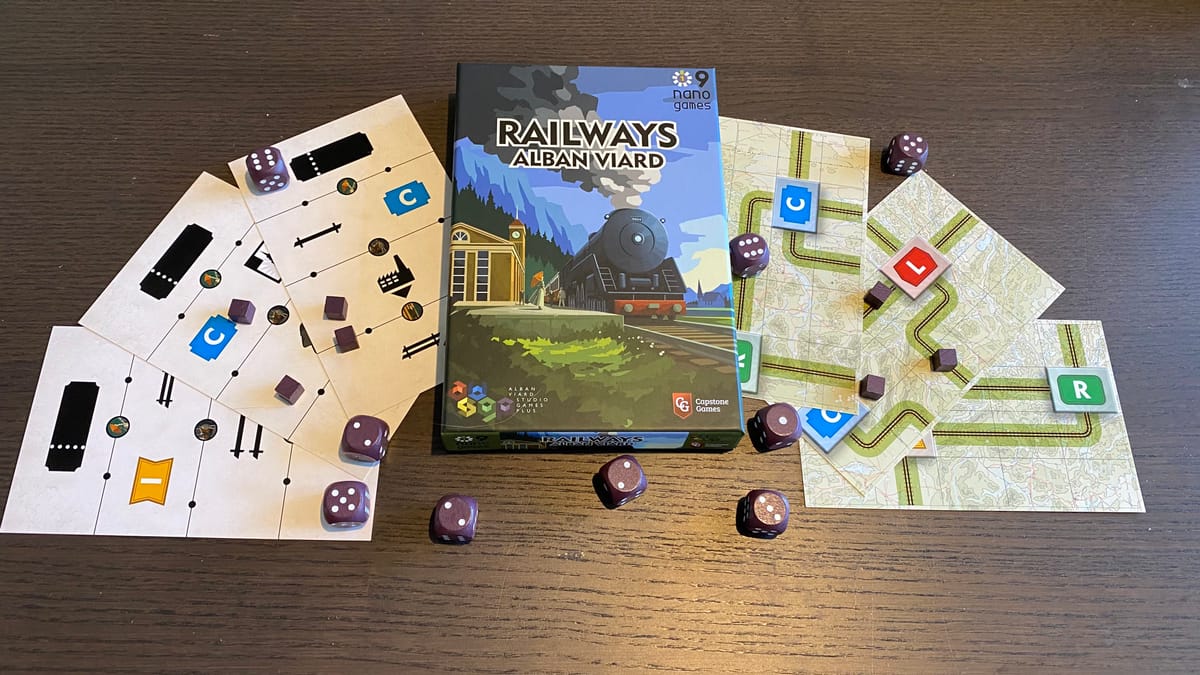
Railways is the first in AVStudioGames’ Nano9games series, which consists of small box games that use exactly nine cards, nine dice, and nine cubes as their components. These games have so far been released in 2 “waves” of three games each, with the first wave capable of being combined to form one larger 2-player game that I’ll be reviewing later. This particular game is for a solo player only, and is like a smaller version of designer Alban Viard’s other game, Tramways.
Rules & Components
The rules are laid out well and didn’t leave me with any questions, and they have a reference on the back, which should really be the industry standard by now. I’m not, however, completely clear on the part of the setup where the player assembles the map. It clarifies that the player chooses to place the passengers where they wish, but not whether the player gets to control the map cards or if those should be randomly arranged.
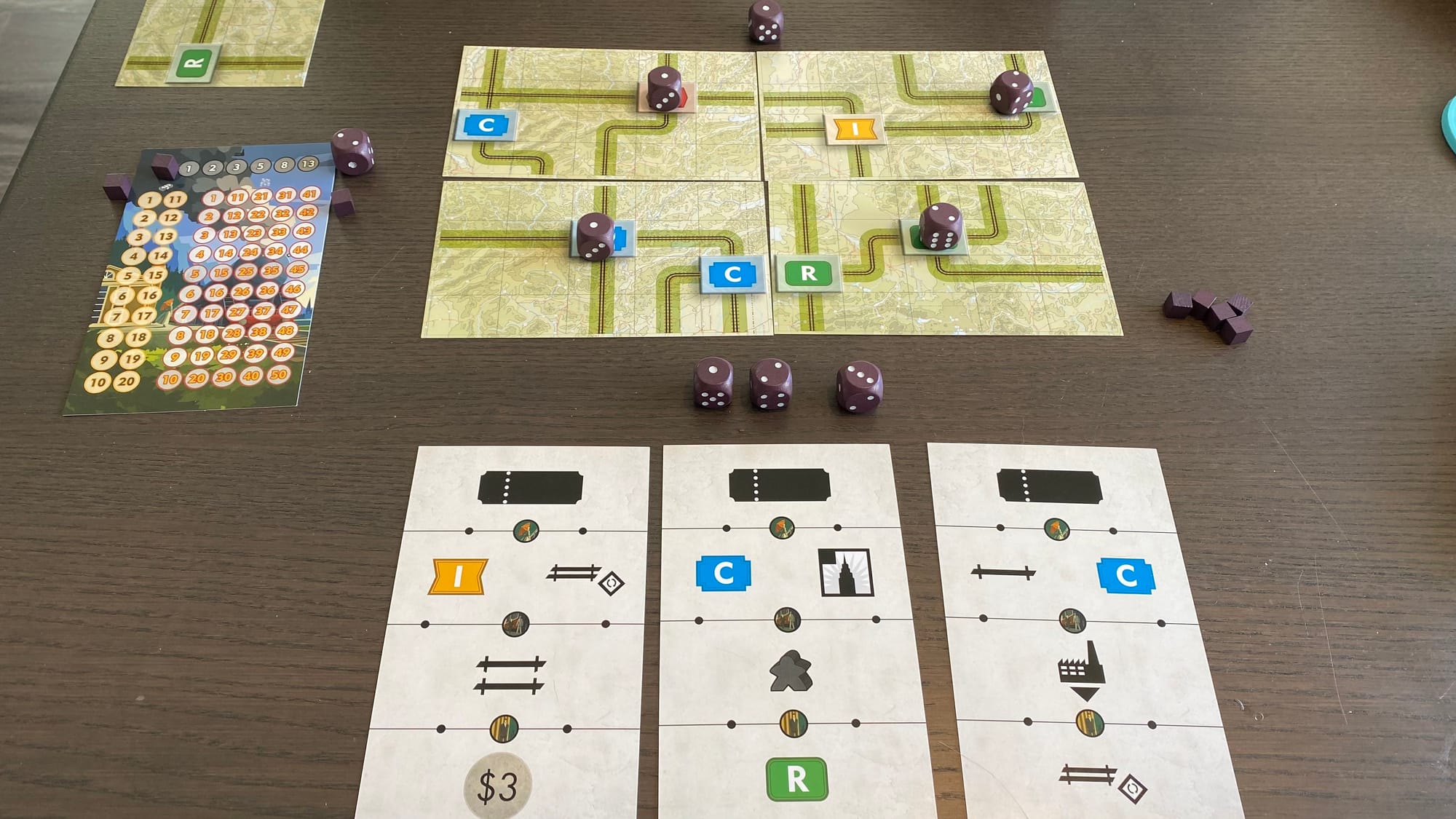
Railways is very component-light, using just 9 each of cubes, dice, and oversized cards. I didn't note any issues with the cubes or dice; they're pretty standard. The dice pull quadruple duty here and, since a couple of them never change "state" during gameplay, they could have been given different colors. This doesn't impact gameplay at all, though, and I didn't mind the single-color components too much. The cards are large and very easy to read. While they aren't super fancy or thick, neither are they super thin and won't be damaged any time soon since the game has minimal shuffling.
Gameplay
Railways is all about, shockingly, building railways, then using these railways to deliver passengers and score as much Profit as possible before the 12th decade is over. Unlike most rail games I've played, the player doesn't get to choose where these rails go. The only buildable rails are those already printed on the cards, though there are ways to link tracks, which I'll get to later.
At the start of the game, all the cards—except the tracker card, of course—are mixed together and four are dealt into a grid to form this game's map. The rest of the cards become the player's deck, with three of the four as the starting hand. With the map assembled, passengers are added to one building (the colored boxes) on each card. This is what I mentioned earlier about the rules; it's not explicitly stated that the layout is entirely up to the player. I chose to assemble both the maps and the passenger dice in the way most beneficial to me (at least, I think it was the most beneficial), but this could be a way for players to customize their game difficulty.
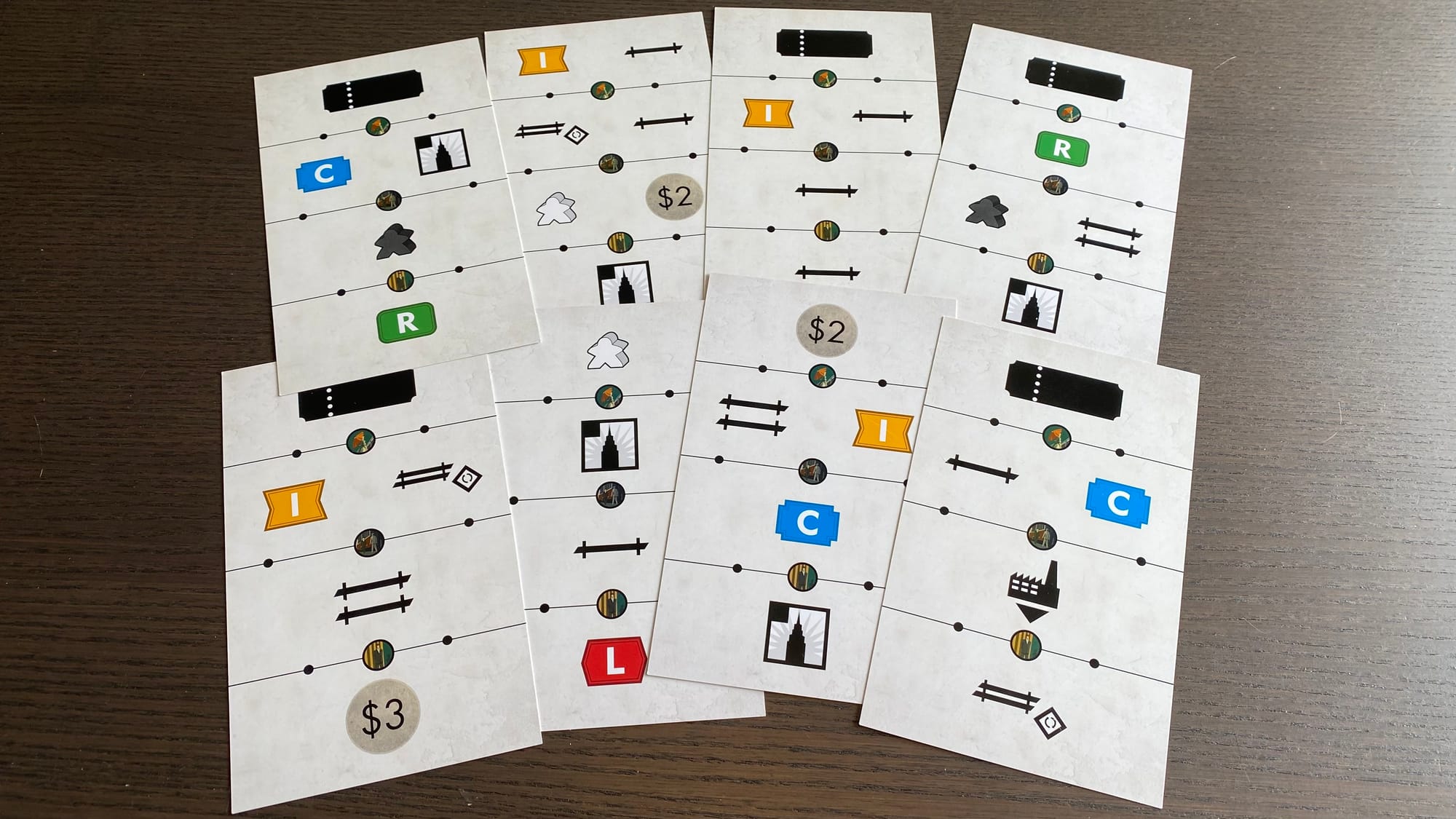
Each decade, the player gets to perform 1 or 2 actions using their hand of cards. Actions use the icons from the cards and can be done with a single card, or they can use up all three (though that would mean the player only gets a single action this decade). Actions can even use multiple rows of icons from a single card, but doing so will increase the Pollution track, which penalizes the player at the end of the game and gets increasingly difficult to reduce as it advances.
These icons fuel actions, depending on what you want to do. For example, to build a railway, you need a number of rail icons (the horizontal bars) equal to the length of track that you’re building. Additionally, you need an icon matching one of the buildings on either end of the track. After discarding the cards and gaining any pollution necessary to meet those requirements, you also need to spend one Railworker by decreasing the Railworker die. This is the only use for the Railworker die, and you won't build that many rails, so spending it doesn't seem to mean much. Finally, you get to place a single cube, aligned with the grid, in any of the track spaces. Later, you can take an action and use the upgrade rail icon to, you guessed it, upgrade the railway. Upgrading a rail simply means rotating the cube 45° so that it's worth more Profit when a passenger is transported across it.
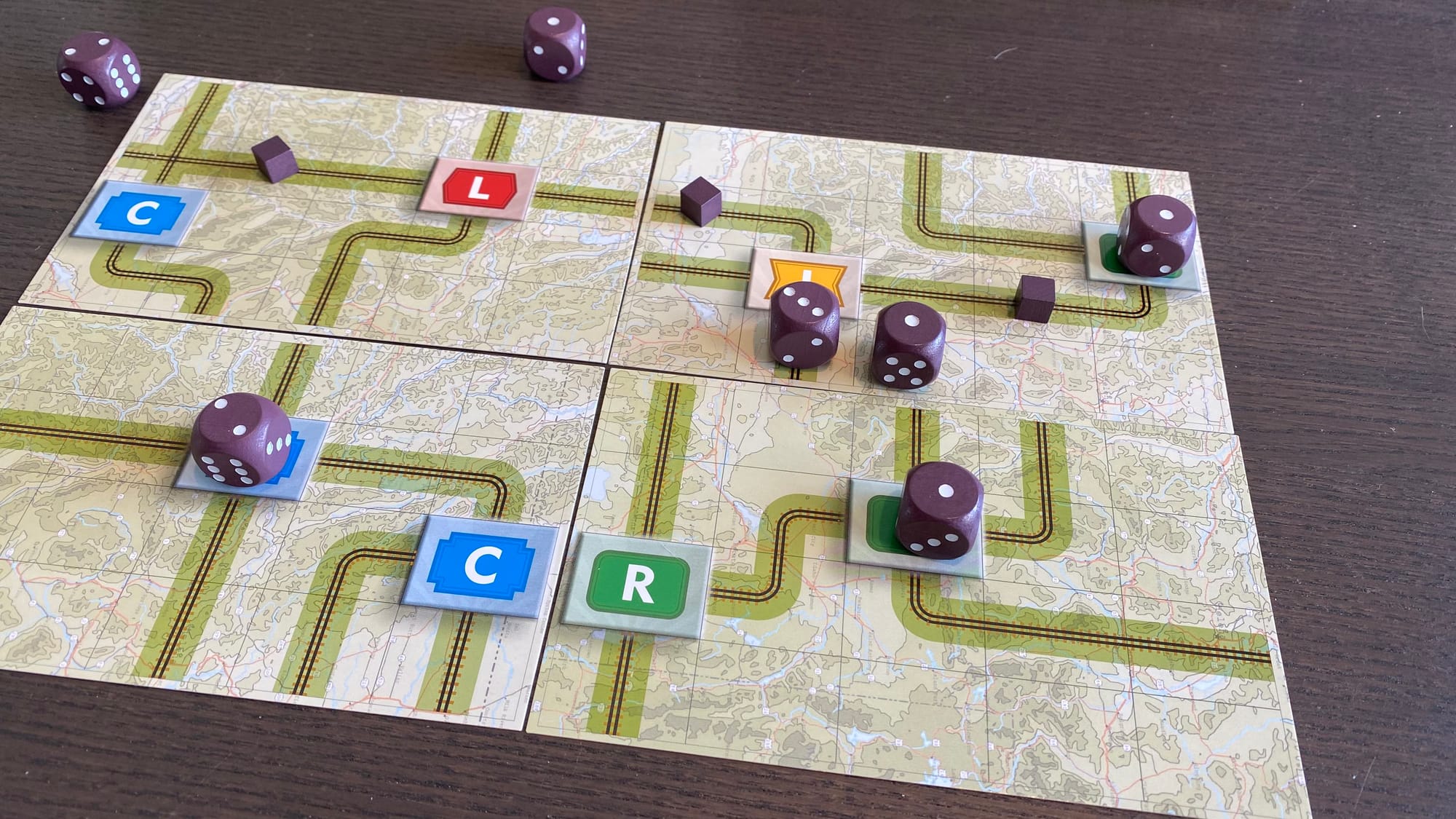
I won't go into the mechanics of each action, as that's most of the rulebook itself, but each icon on the cards correlates to a single specific action you can take. The only exception to this is the building icons, those colored boxes with a letter in them. These icons serve more to target specific locations with your actions as part of their cost, rather than having an inherent action themselves.
The dice on the board's building spaces represent passengers. As an action, they can be delivered to a location of your choice across the rails you've built. The more buildings they travel through, the more Profit you'll score, along with a bonus for whichever building they're delivered to—such as gaining even more Profit or reducing your pollution. You’ll also gain Capital based on the number of Railway spaces traveled across (double for upgraded Railways), which is spent to build new buildings and to buy Profit with the Leisure building bonus. On the board, this means that the passenger die is decreased without any new passengers cropping up, so there's a bit of entropy as the game goes on. Luckily, there's a way to return passengers to the board, which is also the method for connecting the disjointed tracks that I mentioned earlier.
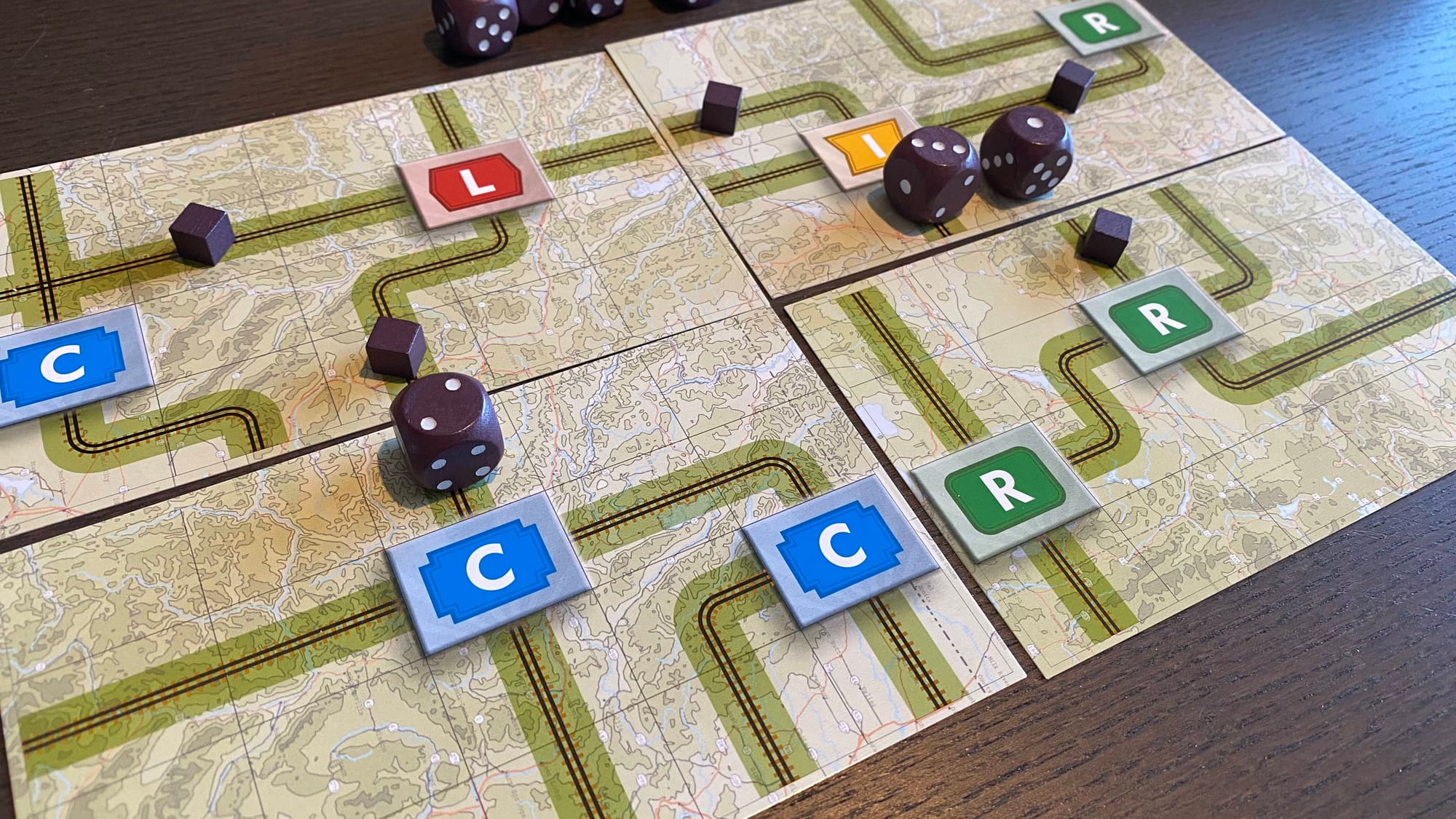
One of the other actions is to place a new building. This building can be placed on its own, even covering a track space, as a Leisure building with passengers equal to the die's face—you start the game with a 1, 2, and 3 die to build and cannot gain more. More useful, though, is that you can place a building die adjacent to an existing building to extend that building. This means you don't need to connect to anything new while effectively gaining more passengers to deliver from the location of your choice. If a new building touches the open end of any track, it's now connected to that track like any of the printed buildings.
A funky effect of these new buildings, which can take some getting used to, is that they aren't necessarily permanent. See, that die represents both the building itself and the passengers available. Whenever passengers are delivered from it, the die decreases. And, just like the initial passenger dice, once the final passenger is delivered, the die is removed from the board. And with it, that fancy building you'd put together. Because of this, you'll need to think twice before depleting a building of passengers, as it may be worth more to keep around.
Review
This game is a little odd. It takes a bit to fully understand all the actions and form your strategy, but once you've got it, the game flows pretty smoothly. There'll be some hiccups, such as when your hand of cards doesn't give you the icons you need to build that last stretch of rail before you start ramping up passenger delivery. Some games will even require drastically different strategies, since it's possible that none of your action cards have the "gain a Railworker" action icon on them. Yet at the same time, every decision feels forced, as there is no real flexibility in where the railway goes or what buildings are where. In my game, I only had one red Leisure building, and its position didn't lend itself to making big Profit-scoring deliveries, so I never sent passengers there. It feels less like I'm building a railway, and more like I'm buying some second-hand network.
Railways’ action icon puzzle is interesting, and I enjoyed the cost-benefit analysis of whether it would be worth gaining pollution to use multiple rows of a card or just wait and hope things line up better next turn. But the puzzle can be solved pretty quickly, with the rest of the game just going through the motions. There’s no pressure in the default goal to “score as much Profit as possible” and the other optional goals (such as delivering all passengers) are fairly easy to achieve. The game is a decent time killer if you’re just looking for something to do while you wait around or sip a hot drink, but not quite engaging enough for me to play it as a main activity.
Railways
Alright
Railways is a light solo game that doesn’t overstay its welcome, and has a unique method of performing actions. The theme doesn’t quite fit the mechanics, since, unlike most railroad games, you don’t really choose the track layout. While the game is more engaging than Solitaire, it isn’t deep enough to give much reason to play more than a couple of times.
Pros
- Nice flow to the gameplay
- Interesting puzzle with action icons
Cons
- Not building a network so much as buying one
- Lacks sufficient depth for much replayability
This review is based on a retail copy provided by the publisher.
